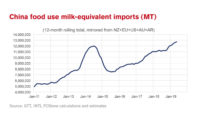
People still need to eat. It’s the self-comforting statement I hear used in the agricultural and food industries when we’re looking at a weakening demand situation. Sometimes the weaker demand is driven by high prices, sometimes by weaker economic conditions, and sometimes by other outside factors.
Right now, there are a lot of headwinds hitting the demand side — all at the same time — causing a perfect storm and anxious consumers. People still do need to eat, but they don’t necessarily need to eat as much dairy, and in a recession, the price they are willing to pay is going to shift lower.
The focus of the global dairy markets also has shifted. From mid-2021 through the first quarter of 2022, prices were rising on weak milk production across the major dairy exports. During the first quarter, EU-27+UK milk production was down 0.4% compared to last year. U.S. production was down 1%, New Zealand was down 5% and Australia was down 5.5%. The declines were driven by high input costs like feed, energy, and labor, as well as poor weather in some places and tightening environmental regulations that are discouraging farmers from boosting production.
Unfortunately, the milk production numbers we have for the second quarter aren’t showing any signs of improvement, yet global dairy prices have been falling since April. What is driving this phenomenon?
First, high dairy prices were tempering demand. Year-to-date imports by countries other than China are down 1.6% while imports by China are down 22%. That puts total global imports down 7%. The weakness in Chinese imports seems to be tied to a few things. First, its domestic milk production grew strongly at the end of 2021 and into early 2022, which has reduced their need to import. Second, consumption growth has likely slowed after surging in 2021. Lastly, the strict lockdowns in parts of the country from March through May hurt demand and there continues to be a lingering impact on food service. So, global demand was already weak before concerns about recession became more prominent.
While there is a debate about whether we will see a full-blown recession or not, central banks around the world are intentionally trying to slow their economies to get inflation under control. Slower economic growth is rarely good for commodity demand and we’ve seen prices for energy, grains, and dairy all trending lower during June and the first half of July. That has taken some of the pressure off input costs for dairy farmers, but with dairy prices also shifting lower, the margin forecasts haven’t changed much.
We still have upside risks for global dairy prices. First, poor weather that dents crop yields or hurts cow comfort could keep the expected recovery in milk production weaker than forecast. Second, China is still a big driver of global demand and its buying is hard to predict. It’s possible it could buy more than expected late in 2022 and into 2023. We also have some significant risk around natural gas supplies in Europe, especially in Germany.
Additionally, it’s possible Russian gas supplies could be cut off, which will force some level of rationing across industries. As of mid-July, we don’t know where dairy plants rank in that hierarchy. Certainly, drying powders is more energy intensive than bottling milk or making cheese or butter. So, the global dairy markets could see a boost from tighter powder production in Europe this winter.
When we look back at dairy prices in the 2008/2009 and 2001 recessions, they didn’t bottom out until 12 to 24 months after the start of the recession. That would argue for continued weakness in dairy prices during the second half of 2022 and possibly into 2023, but we need to keep an eye on the supply situation because it continues to be weaker than expected globally.



